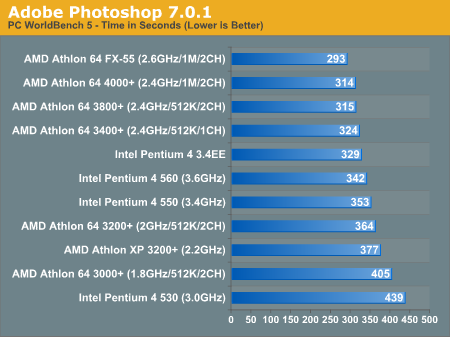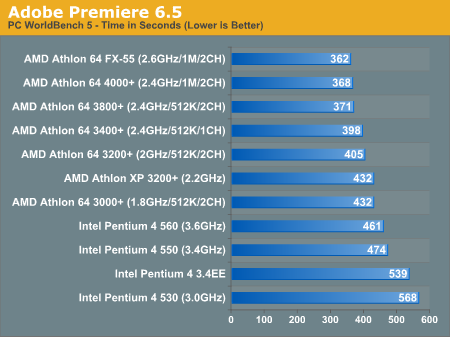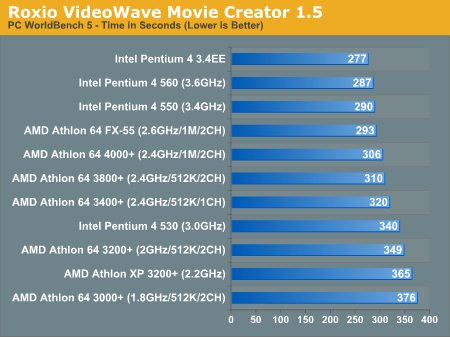AMD Athlon 64 4000+ & FX-55: A Thorough Investigation
by Anand Lal Shimpi on October 19, 2004 1:04 AM EST- Posted in
- CPUs
Video Creation/Photo Editing
Adobe Photoshop 7.0.1
With the later releases of the Athlon XP, AMD began to offer fairly solid performance in Photoshop but with the Athlon 64 AMD managed to seal their fate - making AMD the platform of choice for Photoshop users.
The Top four spots in WorldBench's Photoshop 7 test are won by AMD, first by the 2.6GHz FX-55 and then by the three chips at 2.4GHz. As we've seen in the past, image editing doesn't benefit all that much from high bandwidth memory subsystems, so there's little benefit from a larger cache (0.3%) or from a dual channel memory setup (2.7%).
Despite its higher clock speed, the Pentium 4 560 takes a back seat to the Extreme Edition, justifying the EE's continued presence for a little while longer. Though with plans for a Pentium 4 4GHz scrapped, it seems like we'll be seeing a lot more of the Extreme Edition.
Athlon XP owners will find little reason to upgrade to an entry-level Athlon 64 for Photoshop use, as the two 3200+s manage to perform very similarly despite architecture and clock speed differences.

Adobe Premier 6.5
Prescott seems to do quite a bit for Intel here, with the 560 and 550 easily offering better performance than the 3.4EE, despite smaller caches. That being said, even the top of the line Pentium 4 560 can't outperform even the Athlon XP 3200+ in this test. While WorldBench does use an older version of Premier, it is one that is still widely used, making these results quite pertinent.
Once again we see very little need for the larger cache of the Athlon 64 4000+, but more of a tangible benefit from the move to Socket-939 from Socket-754 (6.7%).
AMD simply dominates this test; Premier users should know what platform is right for their needs.

Roxio VideoWave Movie Creator 1.5
While Premier is a wonderful professional application, consumers will prefer something a little easier to use. Enter: Roxio's VideoWave Movie Creator, a fairly full featured yet consumer level video editing package.
Intel has worked very closely with Roxio in the past, thus it's no surprise to see Movie Creator take advantage of the Prescott core as best as possible. The Extreme Edition still takes the crown, but the 560 and 550 manage to keep AMD's best at bay.
The Athlon 64 FX-55 is still within striking distance of the 3.4EE at only a 5% deficit, but the gap grows as we look at cheaper AMD solutions. Intel wins here with AMD in a close second.











89 Comments
View All Comments
coolme - Monday, January 10, 2005 - link
#85 yeah, but when comparing to Tom's Hardware review, it's totally off track... (Tom's is more believeble because there is pics of how he measured it and based on the fact that there is no way a A64 could handle 200+ watts)http://www6.tomshardware.com/cpu/20041115/pentium4...
how Tom tested it: http://www6.tomshardware.com/cpu/20041115/pentium4...
eight - Monday, December 27, 2004 - link
Has anyone information about A64 performance with Premiere Pro 1.5? I assume thet A64 does beat P4, but assumption is mother of... :)euanw - Tuesday, November 9, 2004 - link
#44Wesley,
I am very impressed by your articles. Can you inform me of the procedure you used to overclock the FX55? With the Neo2 board I am not clear on CPU vid and CPU voltage, what do they mean? When I change the multiplier to 13.5 my new PC reaches winXP and then reboots.
My setup is MSI K8N-Neo2-54G, FX-55, 2 x 512MB - OCZ EL DDR PC-3200 Platinum Rev2, Nvidia Quadro FX3000, 2x Seagate Barracuda 7200.7 120 GB, Matrox RTX-100 real time video editor, Antec TrueBlue 480W ATX-12V, BenQ DVD Dual DW1610, WinXP-SP2.
euanw - Tuesday, November 9, 2004 - link
#44Wesley,
Gioron - Sunday, October 24, 2004 - link
While I'm unsure of the exact method used in this review, I'm sure that there is no built-in power measurement devices on the motherboards and processors listed (unless its new and no one told me...) so its NOT just just a matter of installing software that can read a sensor thats already there (as in all the CPU temp monitors). This means it requires some hardware to measure the voltage and current flow to various components (or you can cheat a little and assume the voltage is constant and just measure current).Unfortunately, this is not as easy as it sounds, since isolating various components can be a problem. Its fairly easy to measure things like hard drive power useage since there is only one power connector going to it and its easy to access, so you measure the current on the 5v line and the current on the 12v line, and you're pretty much done. Things like CPUs, motherboards and graphics cards are a bit more difficult. On the newer graphics cards you can measure the power consumption from the additional molex connector, but in all likelyhood, the card will also draw a certain amount of power from the AGP slot power lines, and no one in their right mind is going to unsolder the AGP slot and raise it half an inch in an attempt to put a current sensor in line with the power leads. Thus, you need to rely on indirect means and educated guesses. You can measure the current going into the motherboard, but how much of that is going to the chipset, the CPU, the RAM and the graphics card? You can swap in a different CPU and see how it changes, but that won't give you absolute readings. You can try to remove the CPU and see what power the MB uses without one, but odds are it'll use more power when its actually interfacing with a CPU instead of beeping error codes at you.
Bottom line: There is no easy way to measure power consumption, and even dedicated hardware review sites have problems with it. Personally, I trust Anand far enough that I'm sure he didn't completely screw it up, and the numbers he has are probably close enough to the real thing. I'd forget about measuring power for myself.
xsilver - Friday, October 22, 2004 - link
Kinda late on the comments but..If anand or anybody can answer -- what is used to measure the "power consumption" software? or hardware? links? I would like to test this myselfthanks
Bakwetu - Friday, October 22, 2004 - link
Whoah, it's been a while since I checked out cpu reviews and I must say Amd has some impressive cpu:s nowadays. Even though I am budget oriented when it comes to buying hardare, I'd choose the 3400+ model before the 3200+, it's not all that much more expensive and seems to perform much bettert - Friday, October 22, 2004 - link
79uhuh.... and in a server type situation, how many raid arrays are ran off the chipset controllers? not many i would wager..
hell... u prolly have an independent fibre optic raid array :)
hardware, baby, hardware.
t.
knitecrow - Friday, October 22, 2004 - link
I always knew women were trouble when it comes to technology ;)screech - Thursday, October 21, 2004 - link
nice ones #79, 78. :)